Bioactive Substrate Kits For 15 Gallon Aquariums
Vivarium Base Kits made with the best bioactive terrarium substrates
Drainage

Drainage:
3 Gallons
NEHERP LDL Media
$8.49 -
$7.49/ea
$8.49 -
SALE: $6.99/ea!
Substrate

Substrate:
3 Gallons
Your Choice Of Mix
$11.99 -
$9.99/ea
$11.99 -
SALE: $8.99/ea!
Leaf Litter

Leaf Litter:
1 Gallon
Assorted
$10.99 -
$8.99/ea
1 Gallon
See Below For Details
Screen Sep.
Screen Separator

Screen Separator:
24x12
(Inches)
~5% Off
Microfauna

Microfauna:
Optional
Springtails + Isopods
Up To 26%+ Off!
Springtails

Springtails:
16oz Culture
(Optional)
$13.99 -
As low as $9.99!
Isopods
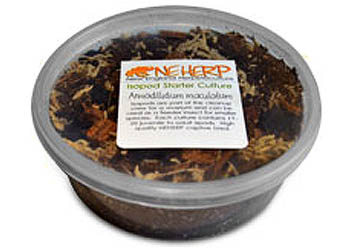
Isopods:
8oz Culture
(Optional)
$13.99+ -
As low as $10.49!
15G Vivarium Substrate Kit Summary:
3 Gallons Of Vivarium Substrate (Choose In-Cart)
3 Gallons Of Lightweight Drainage Layer Substrate
1qty 24x12 Custom Cut Screen Separator
1 Gallon Of Assorted Leaf Litter Substrate
16oz Springtail Culture (Choose In Cart)
8oz Isopod Culture (Choose In Cart)
3 Gallons Of Vivarium Substrate (Choose Below)
3 Gallons Of Lightweight Drainage Layer Substrate
1qty 24x12 Custom Cut Screen Separator
1 Gallon Of Assorted Leaf Litter Substrate
Optional 16oz Springtail Culture
Optional 8oz Isopod Culture
Leaf Litter is currently sold out, and has been automatically removed & discounted from your kit to prevent delays.
Save up to $18.67 vs. purchasing things separately!
15G Substrate Kit Starts At $64.75
(Customize & see details in-cart)

Save up to $23.17 vs. purchasing things separately!
15G Substrate Kit Starts At $60.25
(Customize & see details in-cart)

15G Substrate Kit Starts At $55.76
(Customize & see details in-cart)

15G Substrate Kit Starts At $51.26
(Customize & see details in-cart)

Stock of V1 Substrate is low. If selected, please allow 5 days to ship.
Stock of V2 Substrate is low. If selected, please allow 5 days to ship.
Stock of ABG Substrate is low. If selected, please allow 5 days to ship.
Stock of LDL Substrate is low. If selected, please allow 5 days to ship.
Stock of Leaf Litter is low. This kit may take up to 5 days to ship.
V1 Substrate is currently sold out.
V2 Substrate is currently sold out.
ABG Substrate is currently sold out.
Springtails are currently sold out.
Isopods are currently sold out.
About Your Substrate Kit
Our NEHERP Terrarium Base Kits are designed to turn a basic glass enclosure into a living "bioactive" ecosystem. This kit is suitable for both planted terrariums without inhabitants, and live vivariums housing a variety of different interesting creatures. Each kit includes all the high quality supplies you'll need for the strongest & most proven foundation layers available. With over a decade on the market, no other specialty brand of vivarium substrate has been so well proven to offer long-term results. Our substrates are used in Zoos, Museums, Nature Centers, and in thousands of private collections all over the USA. We're confident you'll be thrilled with the kit's performance! Continue reading...
Our 15G base kit includes enough substrate to create a 2.5in deep layer of each, as recommended in Vivarium Construction 101. A slightly oversized pre-cut screen separator is included specifically for the 15G enclosure, in an effort to ensure proper fitment. An adjustable quantity of our high quality (assorted) leaf litter is part of the kit, which is an important part of any well designed living ecosystem. Springtails, Isopods, and plants rely on the included leaf litter as a continuous source of nutrients, as it slowly breaks down within the enclosure. This is meant to be topped-up every few months as the ecosystem processes it into available nutrients, and the amount of leaf litter in the kit is customizable to your personal preferences. Lastly, high quality Springtail and Isopod cultures are an available option at up to 25% off purchasing them separately!
Our 15G base kit includes enough substrate to create a 2.5in deep layer of each, as recommended in Vivarium Construction 101. A slightly oversized pre-cut screen separator is included specifically for the 15G enclosure, in an effort to ensure proper fitment. High quality Springtail and Isopod cultures are an available option at up to 25% off purchasing them separately! Our top-quality Leaf litter isn't available at the moment, so we recommend picking some up separately at this time.
Not sure what else you need? We've got total support for your 15 Gallon Aquarium! Just add lighting, plants, and a (optional) background kit to create an exhibit-quality enclosure. Check out Vivarium Construction 101 & 102 for detailed instructions about the process. As always, every NEHERP Substrate Base Kit qualifies you for free 1-on-1 email consultations if you have questions or concerns now or in the future! 
Frequently Asked Questions
Question:
What about a layer of Sphagnum on top of the substrate?
Answer:
Some vivarium builders add a thin layer of Sphagnum moss on top of the substrate layer. There are pros & cons to this practice, and neither way is wrong. Sphagnum can act as a barrier between the substrate and inhabitant species, to prevent particles from sticking to sticky species. (Frogs, salamanders, etc) For enclosures which are a little more dry (near 55% R/H), Sphagnum can hold a little extra moisture and lock it into the substrate layer below. It's softer than Substrate, and can easily be wrapped around moisture-sensitive plants when low humidity is an issue. On the downside, it does decrease the amount of air which can penetrate to the substrate layer, which can decrease it's performance & longevity. Sphagnum Moss itself will also break down faster than the substrate, so it may end up needing to be replaced (or removed + replaced) sooner than the substrate would. In our opinion, Sphagnum's long fibers pose a little more of an impaction risk than NEHERP Moss, Leaf Litter, or Natural Wood Decor would as ground cover. When we build enclosures at NEHERP, we don't typically add a layer of Sphagnum moss. However we do offer Sphagnum for sale separately, if that will be part of your build.
Question:
Can I use "X" as substrate instead?
Answer:
Improper substrate choice is one of the most common mistakes made by beginners, and is a leading cause for vivariums failing prematurely. Topics like drainage, aeration, pH balance, resistance to breaking down, and the ability to support flora + microfauna life long term should all be considered when choosing a vivarium substrate. Coconut fiber, peat, top soil, and/or potting soil (alone or mixed together) are not acceptable substrates for long term success in a live temperate/tropical vivarium. While coconut fiber and peat are ingredients in a live vivarium substrate, they make up a very small percentage of a proper vivarium substrate mix. Inappropriate substrates will compact over time and will not support plant, fungi, microbes, or microfauna as effectively as our vivarium substrate will. For a whole lot more info on this topic, check out Vivarium Construction 101's sections relating to substrate.
Question:
How long will the substrate kit last?
Answer:
That depends on a number of different factors. Substrate used in enclosures which sit at 99% humidity year-round will inevitably break down a little faster than it would in a more typical 75-85% relative humidity range. Enclosures with lower humidity will see substrate last even longer. Adding a water feature will reduce the longevity of substrate by half or more unless it's done with an incredible level of detail. To put it simply, if a vivarium is set up and maintained as described in Vivarium Construction 101 & Vivarium Construction 102, the lifespan should range up to 5-8 years.
Question:
I read that I should bake and/or rinse substrate before using it?
Answer:
We don't recommend either. Any potential beneficial mycorrhizal fungi may be killed in the baking process, and our substrate doesn't have "bad stuff" in it which needs to be baked off. It's true that some types of Coconut Fiber should be rinsed before use, but we don't use typical horticultural coconut fiber in our mix. We use pet grade coconut fiber specifically labeled & sold for immediate use with Reptiles and Amphibians. The same claim "pet grade" statement also applies to our Fir Bark, and Cypress Mulch. Feel free to look into our ingredients list & production process. You won't be disappointed. 
Question:
What types of environments are these suited for?
Answer:
Our substrates are appropriate choices for environments ranging from 55% to 99% relative humidity. (Perfect for the vast majority of popular vivarium species!) Environments with humidity towards the lower end of that range may require more frequent misting to ensure the plants, microfauna, and mycorrhizal fungi have enough access to moisture to thrive.
Question:
Is this a "Self Cleaning" and/or "Bioactive" substrate?
Answer:
The substrate is considered biologically active, although that is a fairly broad term which we don't really use too often in-house. More specifically, our substrate is designed to sustain healthy populations of mycorrhizal fungi, beneficial microorganisms, and microfauna, which all work together to process detritus. If it's built to VC101 & VC102's specs, and there is enough light to support healthy plant growth, then the enclosure should be a fully functioning micro-ecosystem.
A vivarium's biology isn't nearly as simple as saying "Springtails eat all the waste within the enclosure". It's exponentially more complex & interesting than that. To ultra-simplify the basics into one giant run-on sentence: Healthy plant growth fosters the mutualistic relationship between plants & mycorrhizal fungi, the fungi help increase each plant's access to carbohydrates & nutrients, and the microfauna and other microorganisms feed on nutritious shed plant leaves, leaf litter, and decaying parts (fruiting bodies/mushrooms) of the fungi. The activity of each of these relationships increases as time goes on & populations grow. When an animal is eventually added, these processes can work together to help break down the associated waste. To sum it up, soil (or in this case substrate) biology is awesome.
Whether or not an enclosure is "self cleaning" (in terms of animal waste) depends on the size of the animal and the overall setup of the vivarium. In our experience, animals which digest plant, fruit, and insect matter produce waste which is far easier to break down than animals which consume larger & more complex organisms like vertebrates. Vivariums for Amphibians are easily designed to be self-cleaning. If you are working with any species of Gecko (from the tiniest Sphaerodactylus to the largest Rhacodactylus), you can rest assured the enclosure will be a fairly "hands off" affair. Invertebrates like Arachnids, Mantids, and more will be a piece of cake for the environment to process. Even most small-to-medium sized insectivorous & frugivorous lizards should require little-to-no cleanup. Larger species which consume a primary diet of vertebrates are more likely to require some spot cleaning within the enclosure. Building a live vivarium for a very large Reptile can be a fairly difficult process. Don't hesitate to contact us if you aren't sure!

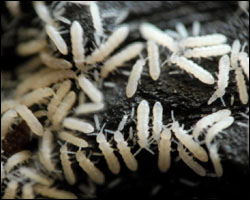
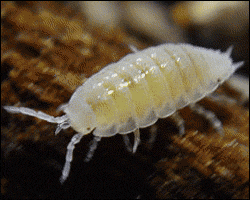

Info: Springtails & Isopods
Springtails and Isopods play a critical role in the biological function of a live vivarium environment. These little critters do a great job of helping to process fallen leaves and other detritus produced by co-habitants. While often referred to as a "clean up crew", these detritivores are actually responsible for the natural fragmentation of organic matter within the enclosure. (Essentially breaking things up by agitation, chewing and/or digestion) Further decomposition takes place thanks to fungi and microbes which eventually break down many of the elements into plant-available nutrients. From there, the plants work with mycorrhizal fungi to utilize the available nutrients to grow, produce oxygen, and keep the natural cycle flowing.
Deciding On Microfauna:
All live vivariums built to our recommended specifications will require at least Springtails. If the animal you are working with is under 3/4in or an invertebrate, it's possible the enclosure will not require the addition of Isopods. If your inhabitant is over 3/4in, we strongly recommend using both Springtails & Isopods. (Note: the "Kit Only" option (without Springtails or Isopods) was made available for hobbyists who already have microfauna cultures!)
About The Cultures:
These are the same high quality Springtail & Dwarf Isopod cultures we sell separately, only discounted for your base kit. The Springtail species is always Folsomia candida, and the Isopods are breeder's choice. (Either 'Dwarf Gray', 'Dwarf Purple', or 'Dwarf White') Printed care sheets & instructions are included for each type.
Introducing Springtails & Isopods:
Our Springtail and Isopod cultures are designed to be poured directly onto our substrate after a vivarium has been mostly completed. We recommend gently pouring the culture's contents into an enclosure after adding plants but before adding leaf litter. Ideally, the area where leaf litter will be should be "open substrate" at this point, so it's a perfect place to pour-out your Microfauna populations. Once they've been added, leaf litter can be gently poured on top of the location, so their first food source will be nearby! From there, Springtails & Isopods will slowly spread & reproduce within the habitat and should sustain a healthy population indefinitely.

Live Vivarium Base Layers
Every live vivarium starts with a few basic layers, which will provide a base for live plants & microfauna to thrive within the enclosure. For more information on the purpose of each layer, check out the links below.
(Links leave this kit page)
V1 Vivarium Substrate
For Environments Ranging From 75-99% R/H


V2 Vivarium Substrate
For Environments Ranging From 55-90% R/H

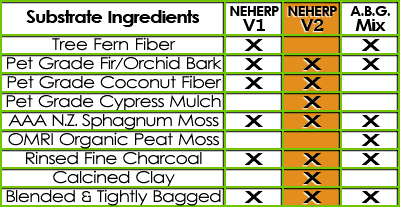
ABG Vivarium Substrate
For Environments Ranging From 75-99% R/H


Vivarium Substrate Comparison


V1: For Enclosures Ranging From 75-99% R/H
V2: For Enclosures Ranging From 55-90% R/H
ABG: For Enclosures Ranging From 75-99% R/H

About The Leaf Litter:
Leaf Litter might seem like an unimportant addition at first, but it actually plays a crucial role in the life of a vivarium. In nature, most of a forest or jungle floor is covered in leaf litter, with plants & moss peeking out here & there. A top-layer of leaf litter is a great way to increase realism within an enclosure. More importantly, leaf litter releases nutrients into the substrate layer as it breaks down, while simultaneously acting as a food source for beneficial microfauna like Springtails & Isopods. Moss is a great looking floor for a vivarium, but leaving some areas covered with leaf litter will help ensure your live environment will look more realistic and perform better, too!



About Our Vivarium Substrates:
Our company might be best known for our absolute top quality live vivarium substrate mixes, and we have three options available for our base kits. We developed our first commercially available blend in 2009, and have been constantly tweaking & improving it every year to ensure our clients get only the absolute best vivarium substrate on the market.
About Our Production Process:
We carefully pre-mix each of our vivarium substrates for your convenience, so they are ready to use straight out of the bag. Our mixing machine was created using food-safe materials, our bags are food grade plastic, and our quality control is the best in the industry. Although our shop has grown over the years, we still blend vivarium substrate in small batches to maintain a predictable & consistent mixture in every bag.




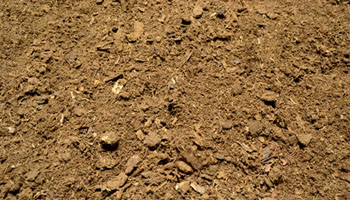



About Our Ingredients:
Our substrate blends use pet grade fir bark, pet grade coconut fiber, pet grade cypress mulch, AAA-Grade New Zealand Sphagnum (milled in-house), and OMRI certified Peat Moss. Hard-to-find Tree Fern, fine Calcined Clay, and rinsed/graded Natural Charcoal are also added as long-lasting aggregates. We use the best possible ingredients in each of our vivarium substrates. Each of our three blends is designed to last long-term while maintaining a healthy pH, resisting compaction, supporting microfauna populations, fostering mycorrhizal fungi, and growing healthy plants.
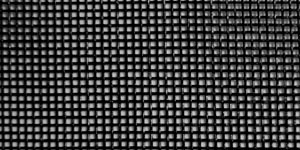
About The Screen Separator:
The screen separator is used to separate the drainage layer & substrate layer. The mesh pattern is small enough to ensure substrate particles don't fall into the drainage layer, and large enough to allow water to freely pass through without pooling. Since water can flow freely downward, the substrate layer won't be prone to oversaturation which helps extend it's lifespan. The fine mesh helps facilitate a healthy drainage layer by preventing substrate particles from falling through & either wicking water upwards, or breaking down in the water table. It's not an exciting product by any stretch of the imagination, but it gets the job done!

About NEHERP LDL Substrate:
LDL (Lightweight Drainage Layer) Substrate is the ideal solution for a live environments lowest layer. It weighs significantly less than gravel pebbles, and has a tremendous amount of surface area for beneficial microbial activity. This helps cut down shipping costs, as well as the overall weight of a vivarium. The drainage layer is the lowest layer in a healthy vivarium environment, and the screen separator, substrate, and leaf litter are stacked above it. The drainage layer permits water to flow freely through the substrate layer during misting sessions, which helps to prevent over-saturation over time. As the environment begins to cycle, the drainage layer will become home to a beneficial population of natural microbes and bacteria.
Our substrate kits are recommended for enclosures built to VC101's specs, ranging from 55-100% R/H. Not recommended for arid conditions.
Percentage discounts and prices may vary slightly due to rounding and do not include any potential sales running now.









